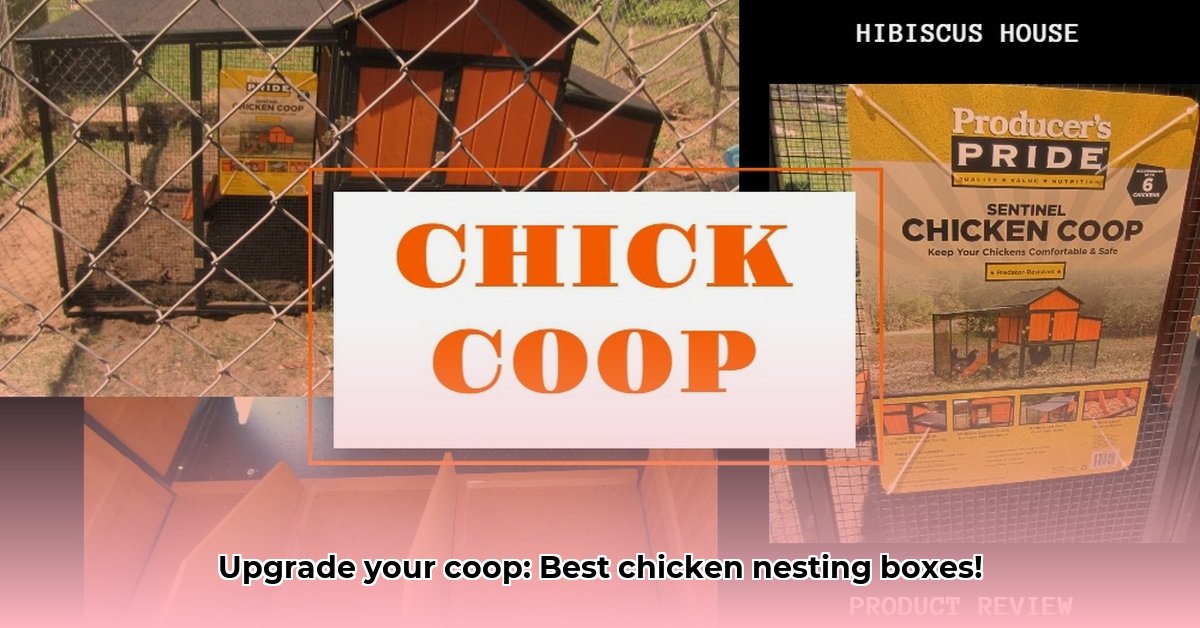
Nesting Box Tractor Supply: Finding the Perfect Home for Your Happy Hens
Finding the right nesting boxes is crucial for happy, healthy chickens and increased egg production. This guide helps you select the perfect nesting box from Tractor Supply, ensuring your hens are comfortable and laying plenty of eggs. Let's explore how to choose the ideal nesting box for your flock.
Understanding Your Chickens' Needs: More Than Just a Place to Lay
Before shopping, consider your flock's size. A general rule of thumb is one box per three to four hens, though more space always leads to happier, less stressed birds and more eggs. Overcrowding can result in fighting and reduced egg production. Each hen needs her own private space, not a crowded communal area. Consider the box size: is it large enough for comfortable sitting and laying? Hens need enough room to move without feeling restricted. Finally, remember location matters. Hens prefer privacy when laying; a dark, quiet corner of the coop is ideal.
Exploring Tractor Supply's Nesting Box Options: Wood vs. Plastic
Tractor Supply offers various nesting boxes, standalone or designed for coop integration. Wood offers a rustic aesthetic and longevity with proper maintenance. Plastic is easier to clean, reducing the risk of disease and pests.
| Feature | Wood Nesting Box | Plastic Nesting Box |
|---|---|---|
| Durability | High, with proper weather treatment and construction | Durable, quality dependent |
| Cleanability | Requires regular maintenance, may need sanding | Easy cleaning; wipe down |
| Cost | Moderate to high | Moderate |
| Aesthetics | Rustic and charming | Functional, may lack visual appeal |
Your Step-by-Step Guide to Choosing the Perfect Nesting Box
Follow these steps for a stress-free shopping experience:
- Count your hens: Determine the number of nesting boxes needed based on your flock size (one per 3-4 hens is a good starting point).
- Measure your coop: Ensure your chosen boxes fit comfortably within your coop's available space, avoiding overcrowding.
- Set a budget: Nesting boxes have varying price points; knowing your budget simplifies the selection process.
- Compare features: Consider wood vs. plastic, assessing cleaning mechanisms and ease of egg collection.
- Read reviews: Online reviews provide insights from other chicken owners, offering valuable tips and perspectives. Don't underestimate the power of user feedback!
- Visit Tractor Supply: Inspect boxes in person to assess quality, size, and material. Hands-on evaluation is invaluable.
- Make your purchase: Once you've found the perfect fit, purchase your nesting boxes and prepare for increased egg production.
How to Implement Precision Irrigation for Reduced Water Usage in Arid Farming
Water conservation is paramount, particularly in arid regions. Precision irrigation significantly reduces water waste compared to traditional flood irrigation methods. It's about targeted water delivery, maximizing efficiency and crop yields.
Understanding the Basics of Precision Irrigation
Precision irrigation is about optimizing both water use and crop production. Unlike traditional, wasteful methods, precision irrigation delivers water directly to plant roots, minimizing evaporation and runoff. This leads to healthier plants, higher yields, and a significantly reduced environmental impact. “Precision irrigation is a game-changer for arid farming,” says Dr. Anya Sharma, Agricultural Engineer at the University of California, Davis. “It allows for targeted water delivery, resulting in healthier crops and reduced water waste.”
Different Types of Precision Irrigation Systems
Various systems exist, each with unique advantages and disadvantages. Drip irrigation delivers water directly to roots, minimizing evaporation. Sprinkler systems offer broader coverage but can be less efficient in windy conditions. System selection depends on crop type, soil, and budget. Consider these factors:
- Terrain: Flat fields are easier to irrigate than sloped ones.
- Crop type: Different plants have varying water needs.
- Budget: Installation costs vary significantly across systems.
Step-by-Step Implementation Guide
- Assess current water usage and crop needs: Analyze water loss and identify water-stressed areas.
- Design the system: Develop a plan tailored to your specific needs. This may involve soil sensors and automated valves. Consult resources or specialists for assistance.
- Install the system: Ensure proper installation by following manufacturer instructions. Professional installation is often recommended for complex systems.
- Monitor and adjust: Regularly monitor water usage, crop growth, and soil moisture to optimize irrigation scheduling and efficiency.
Pros and Cons of Precision Irrigation
| Pros | Cons |
|---|---|
| Higher water use efficiency | Higher initial investment |
| Increased crop yields | Requires technical expertise to operate and maintain |
| Reduced fertilizer and pesticide runoff | Potential sensor malfunctions |
| Improved soil health | Dependence on technology and power supply |
| Better irrigation scheduling control | Possible clogging in drip irrigation systems |
Key Takeaways:
- Precision irrigation significantly increases water use efficiency in arid farming.
- Several systems (drip, sprinkler, etc.) are available, each suitable for different conditions.
- Effective implementation relies on careful planning, professional installation, and ongoing monitoring.
- Despite higher initial costs, long-term water savings and increased yields generally make it a worthwhile investment.